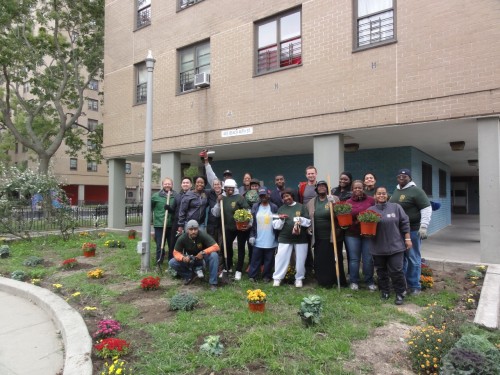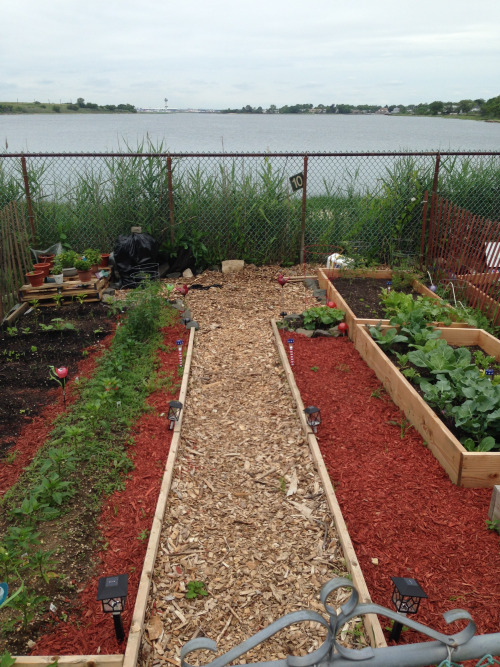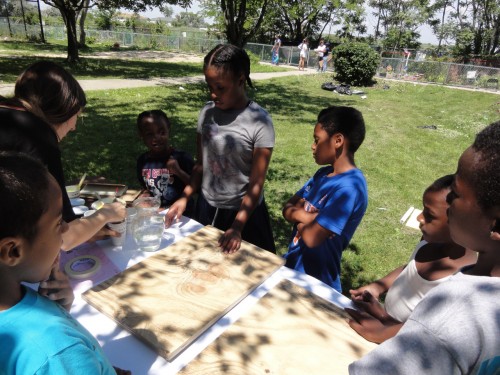For the Lee family, their community garden represents Arirang (아리랑), a stirring Korean folk song with a message of overcoming an obstacle big as a mountain pass.”We were handing out flyers about an upcoming workshop and I saw the Lee family putting in a new garden sign. Mr. Lee sang the song to me. It was an honest, heartfelt moment. He was explaining how deeply this word connects with him, his family and his culture.”
This week, Renae Reynolds, a project coordinator and on-the-ground researcher in the Landscapes of Resilience project tells us about the dedication of the Lee family and others in their post-Hurricane Sandy community garden space at Beach 41st Street Houses.

For several decades before Hurricane Sandy this housing complex on the bay side shore between JFK airport and the Atlantic Ocean held a hidden gem. An impressive community garden with 30 plots has provided food and social engagement for hundreds of residents. This community garden is one of 3500 across all of New York City’s Housing Authority properties. An impressive 670 residents are dedicated gardeners in these spaces. After Hurricane Sandy, residents worked together to bring the disrupted gardens back to life. With the support of the TKF Foundation and the Landscapes of Resilience project the gardens will be enhanced with a pergola, benches, lighting, trees, landscaped plants and community created signage.
Nature Sacred: Tell us about yourself and how you became involved with this project.
Renae Reynolds: I am a 2015 graduate of Parsons New School for Design, Theories of Urban Practice. It is geared towards creating a critical lens towards the city and establishing new ways of engaging with the city planning process. As a resident of Rockaway, I focused on this area throughout my program and was involved in the Rockaway Waterfront Alliance. I was struck by the immediate relevance of what we were discussing in the classroom and what I was seeing and experiencing and learning about in my neighborhood. The impact of Urban Renewal became more salient to me as I analyzed the history of the peninsula. Learning about it’s resort past, a landscape that shifted from low rise, bungalows and opulent hotels to the higher density development, brought more meaning to the buildings and the landscape I experience now, in the present.
Victoria Marshall, my professor, at the time, told me about a project she was involved with in Rockaway (Landscapes of Resilience). She is the landscape architect on the project. I took a field trip out to the garden to see who was there, what was there. I had been living out here for two years and didn’t even know it existed. It is set back from the public housing complex on the bay side. The gardens are adjacent to the bay line. You can’t see it, you have to have an intention to go back there. I started to get to know the residents before coming on to the project. My interests have always been how people navigate their city. What are the elements that give people the impetus to become more involved to change and shape their community?

Tell us about the garden community and your role there.
The residents have an informal garden club, existing before Sandy. People talk about having garden plots before, in the early 90s for example, having stopped gardening for some reason or other and then starting again. In the beginning [of her coordinator position] I wanted to simply be present. I was conducting in-depth interviews with the gardeners. I wanted to get to know the space and who was who first. Sometimes I would just go out there and sit and read. I would introduce myself to gardeners. Over time we would get to know each other. Eventually I could ask, ‘Could you tell me what it was like to lose your garden after Hurricane Sandy and how it is now?’
What are your goals for this project?
My personal goals are in line with the research questions and what we are pursuing. Personally, it is to gain a better understanding of what the community’s involvement or engagement with greening and stewardship looks like. What are these practices of environmental stewardship? What do they look like after some kind of disturbance has occurred? What is the residents’ and the community’s capacity to be involved and how does that contribute to community resilience. What could happen again? I don’t know if that can be answered by the gardens. But…from the practice of managing these spaces, residents gain a sense of ownership of their community and their neighborhood so then they might be engaged in larger discussions about the future of their neighborhood. [Because I am both a] researcher, practitioner, and resident the work I am conducting is participatory in nature. The presence of the Forest Service and the landscape architects offers opportunity that go beyond research and creates new potential to go beyond the initial scope of the project.

Walking through the garden spaces made me think about what other community gardens and small urban farms are here and what interactions those people have with each other. I met people who were interested in networking with peers but hadn’t done it. So I have begun to facilitate this process through workshops and supporting a coalition. We are thinking and talking about bigger ideas such as food production, economic development, health outcomes, and combatting gang violence. The Lees are a good example. They grow cabbage for kimchi. Ms. Lee had buried her cabbage in the garden and she was able to get it and harvest it before the full impact of Sandy. This fermented cabbage provided food for her family when stores where shut down. The sharing of her practices could help other families learn and survive during the next storm.
What accomplishments are you most proud of so far?
The relationships I have formed. Some of the gardeners will call me on the cell phone and I feel like I am a part of this support system. Being able to participate in their monthly garden clubs; being able to have a seat at their table as well. They don’t think I am just an outsider taking photos and being curious. They had no idea who I was at the beginning. Now I am someone to them, and they are someone to me.
We have had other accomplishments though! We have had [design] workshops and a beautification day planting ornamental cabbages around the natural grounds. There are soon to be physical changes, the pergola. We recently had the NYCHA Garden and Greening 52nd annual awards ceremony. The gardens throughout the NYCHA development network receive recognition of their gardening skills. Two of our gardeners received awards; one was a city wide award only awarded to three gardeners! She was a first time gardener and took to it like a fish to water. It was really amazing. I think about the kind of self-confidence she might be gaining from seeing the fruits of her labor, also experiencing the recognition behind that. What that might do for her. She came over to me during the awards ceremony and said she had just received information about teaching others. Not just garden for herself but teach it and do it professionally. That was a cool moment.
In the context of a post-disaster recovery period, what role has the Beach 41st garden played in the community?
From my perspective, it provides people an opportunity to establish if not re-establish social networks that underpin what it means to be socially resilient. [People] develop cooperative relationships among each other and figure out how they want this space to be managed and governed. Sometimes these relationships go beyond the garden space; friendships or sharing information about other things people are interested in. Ultimately the social ties among people are what allow them to act on behalf of one another, especially when a disaster happens. If those social ties go beyond where a person lives and out to other local organizations, for example, those relationships, the local knowledge provided becomes integral to a response effort immediately after and the social support necessary for recovery long term.
You recently coordinated design workshops. Could you tell us more about those?

Our team talked with the gardeners to find out what they needed in the garden. We meshed that with the design ideas we had. The workshop was a collaborative effort between Till Design, resident artist Carmen Bouyer, myself and Elizabeth Gilcrest, we worked with the gardeners and some of their family members to create the signage and messaging which reflected what the garden represented to them. We also planned for global signage beyond the fenced off areas. Gardeners made individual signage so they could express what their garden meant to them. Frances had a garden that she had designed using stones to make a large heart as a central design element. She planted around that heart. She came out to the workshop and she wanted her sign to be a heart. For her, the garden and the heart represent her family.
What do you want others to know most about this project?
The Landscapes of Resilience design project has spurred people on. People are invested and it has shown how much we need to continue to be invested in it. My position as a researcher who also lives in the area I am studying offers me the ability to go and touch and see the garden and the people who are its heartbeat. There is a constant connection, one that I appreciate and one that I hope others can gain from through my participation and through greater visibility of this amazing work.
